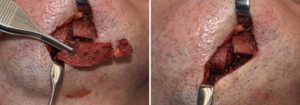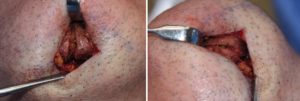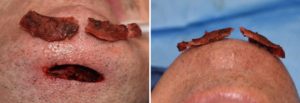Background: Correction of chin deformities is based on what dimensions of it need to be changed. The most common chin deficiency is horizontal for which either an implant or a sliding genioplasty is used to treat it. It may or may not be accompanied with a vertical deficiency as well.
One of the least common chin deformities is vertical excess also known as vertical macrogenia.. This is typically seen when the mandibular symphysis has grown too much in the vertical dimension. The chin looks too long and the lower third of the face is out of proportion to the upper two-thirds of the face. It is also seen in the long face where every facial third is increased.
A unique type of vertical macrogenia is when a chin implant is placed too low on its anterior edge. This can occur from either an inadvertent tilt to the implant or that the whole chin implant is too low, hanging off the edge of the inferior border of the chin. When the chin implant has overhang it will create an implant-induced vertical macrogenia. This is obviously correctable by adjustment of the implant back up into the proper position. But of the implant material allows for substantial surrounding tissue adhesion moving the implant may not be as simple as that of a silicone chin implant.



The tissue adhesion of the surrounding soft tissue of a Medpor chin implant makes it easier and less traumatic to modify its shape in situ. (without removing it) This would normally be very difficult with the exception of its vertical dimension which can be directly accessed and visually seen through a submental incision. Shaving off the overhang back up to the level of the inferior order provides an effective treatment for implant-induced vertical macrogenia.
Case Highlights:
1) A long chin (vertical macrogenia) can be surgically induced by the malposition of a chin implant.
2) Implant-Induced vertical macrogenia can be effectively treated by removal of the chin implant overhang.
3) A submental approach provides the most direct and accurate approach to modify/adjust the implant.
Dr. Barry Eppley
Indianapolis, Indiana




